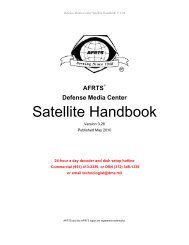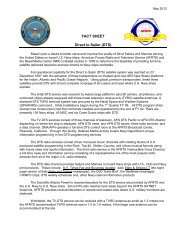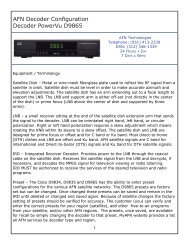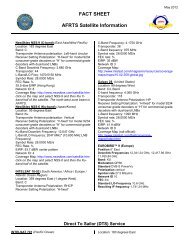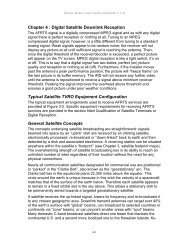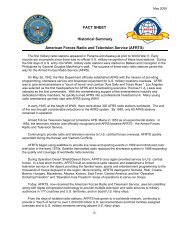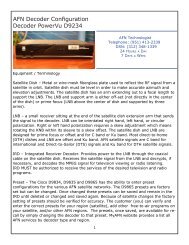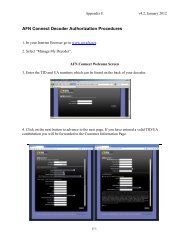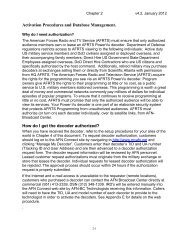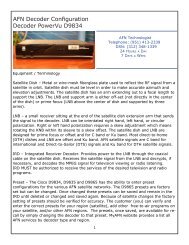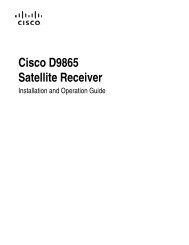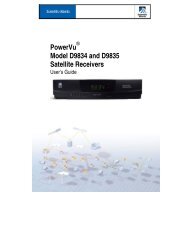AFRTS Defense Media Center Satellite Handbook
AFRTS Defense Media Center Satellite Handbook
AFRTS Defense Media Center Satellite Handbook
Create successful ePaper yourself
Turn your PDF publications into a flip-book with our unique Google optimized e-Paper software.
<strong>Defense</strong> <strong>Media</strong> <strong>Center</strong> <strong>Satellite</strong> <strong>Handbook</strong> V.3.26<br />
Authorization”. Use appendix “D” to check these parameters. On the<br />
model 9834 ensure that the proper pre-set setting is being used for your<br />
region.<br />
a. Network ID<br />
b. FEC Rate<br />
c. Frequency<br />
d. Band<br />
e. L.O.<br />
f. Polarization<br />
g. Symbol Rate<br />
h. Video Standard is (NTSC)<br />
(7) If the signal indicator in the “Receiver Menu” reads No Signal check the<br />
cable from the antenna to the Receiver.<br />
(8) “Reboot” your IRD. Turn off the IRD using the remote control and then<br />
unplug it from the electrical power. Wait a minute and then plug the IRD<br />
back in and turn it on.<br />
(9) Rarely you might be attempting to receive the signal during either a sun<br />
outage or a signal outage caused by a technical problem at the up link<br />
site. These outages would affect an entire region at once so your<br />
neighbors and other service members at your command would have also<br />
lost signal. An easy check is to see if the signal is available at another<br />
receiver in your same location. A sun outage lasts only 10 to 15 minutes.<br />
Sun outages over the United States can affect signals in elsewhere in the<br />
world.<br />
I was receiving the satellite signal but it comes and goes or I get a lot of<br />
freeze frames and digital artifacts.<br />
This is the sign of a weak signal and can usually be traced to one of the following<br />
problems:<br />
(1) Poor connection from the Antenna to the Receiver. Wiggle the<br />
connections to see if you can get the signal to intermit from Loss of Signal to<br />
Freeze-Frames. If so, redo or replace connectors.<br />
(2) Antenna is not peaked for best signal strength or is too small for your<br />
area. See the section of this chapter on signal peaking. Your dish should<br />
be at least the same size as other’s who are watching <strong>AFRTS</strong>.<br />
(3) LNB does not meet specifications. This typically happens with a new LNB<br />
that has replaced a failed on or one from a brand new installation. Heat<br />
and cold will often cause a marginal LNB to lose signal.<br />
(4) Poor quality cable or connectors in use or impedance mismatch. Make<br />
sure that you are using the proper RF cabling between the LNB and the<br />
5-20



